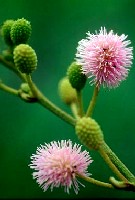| DESCRIPTION: It is a prickly mimosoid shrub. Stems are branched, 2-6 m long, with dense growth. The stem has 5 ridges from which spines and bristles arise. Leaves about 20 cm long and pinnate. USE: It serves as a pollen source for bees. Wood is used as fuel. The root yields 10% tannin. It is used in tropical Africa as a tonic and for diarrhoea, gonorrhoea and blood poisoning. It relieves swelling and in Zambia, the root ash is sprinkled over leprous patches on the skin. The seed is emetic and an expectorant and is used for tooth troubles. In Thailand it is used for erosion control, green manure and cover crop. It is grown at the damp water-inlet areas in reservoirs and removes debris from floodwater entering the reservoir. GROWING PERIOD: Perennial. COMMON NAMES: Black mimosa, giant sensitive plant, mimosa, pricky wood weed. FURTHER INF: It is a legume of moist, open sites in the tropics, in Australia, forming monospecific stands and competing with sedgeland and grassland communities so that the ground flora under dense stands is sparse to non-existent. Its favoured habitat is around water and on floodplains. Since the late 1970s, the plant has become a serious weed of pastureland and national parks in northern Australia. It grows quickly, it can withstand drought and floods, and the seeds float. It threatens biological diversity by replacing wetlands with an impenetrable thorny thicket. However, it presents a very different picture in its native range, where its natural habitat is mainly marginal areas of canals, rivers and lakes, and this gives some hope to researchers looking for biological controls. |
